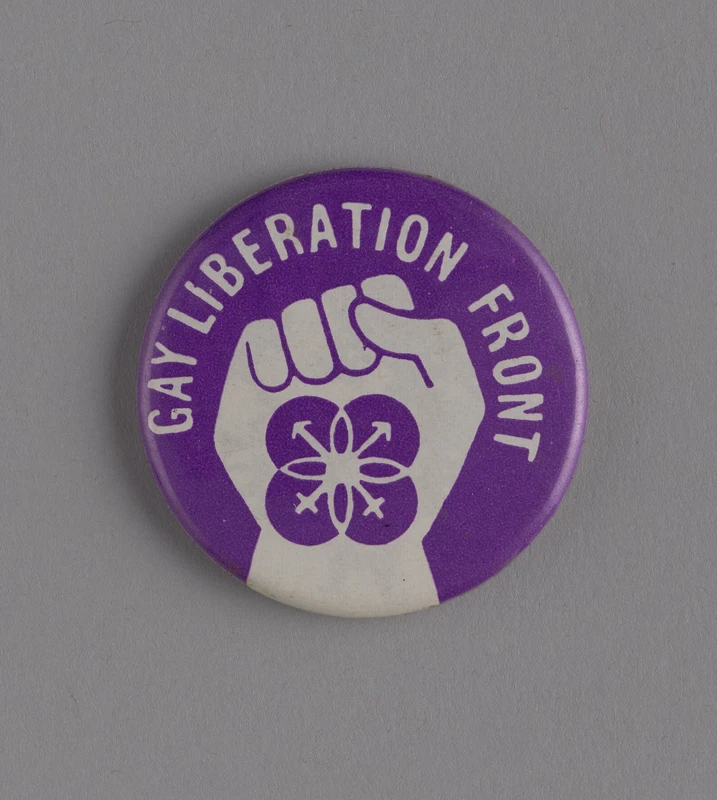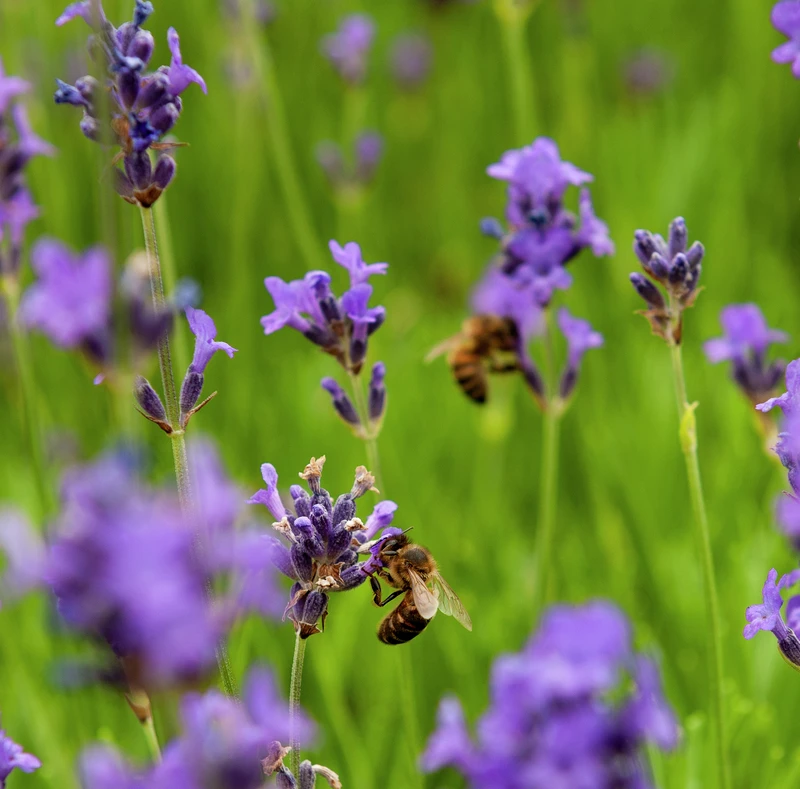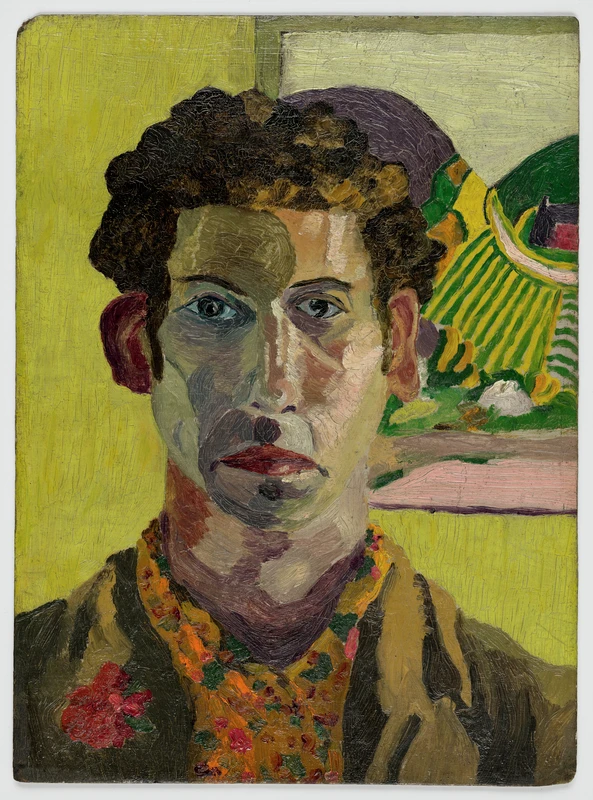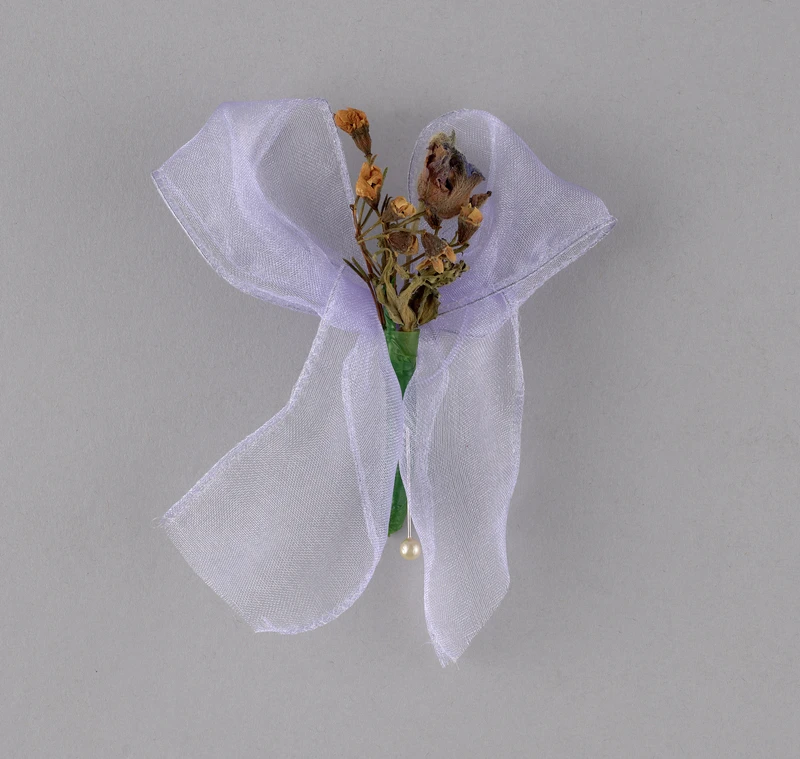Dathlu Mis Balchder! - Hunaniaeth Cwiar: Symbolaeth Blodau a Chymuned
, 19 Mehefin 2025
I ddathlu Mis Balchder eleni, bydd rhai o'n cynhyrchwyr amgueddfa cymru anhygoel yn cynnal gweithdai ar thema Balchder ar draws rhai o'n hamgueddfeydd ym mis Mehefin. Fel rhan o'r dathliad hwnnw, gofynnon ni iddyn nhw fyfyrio ar y themâu a'r ysbrydoliaeth y tu ôl i'w gweithdy a'r hyn y mae Balchder yn ei olygu iddyn nhw.
Mae hanes ciwar yn llawn symbolaeth, ac elfen fawr o hyn oedd symbolaeth blodau. Fel cyfeiriad dilornus neu wedi'i adennill, ac fel modd i gyfathrebu ag aelodau eraill y gymuned, mae blodau yn gwau drwy ein hanes.
Mae fioled wedi'i gysylltu â'r lesbiaidd a'r benywaidd ers canrifoedd a'r carnasiwn gwyrdd yn fodd i ddynion hoyw adnabod ei gilydd. Daeth 'pansi' yn enw dilornus am ddyn merchetaidd ond defnyddiwyd lafant (y blodyn a'r lliw) ers degawdau fel symbol o frwydr a rhyddid cwiar.
Yn archifau Amgueddfa Cymru mae cyfoeth o'r symbolaeth flodeuog hon, mewn bathodynnau protest a gweithiau celf, yn arwydd o'r cyswllt â blodau drwy ein hanes.
Fioled
Yn y 6ed ganrif disgrifiodd Sappho, bardd o ynys Lesbos, ei chariad benywaidd yn gwisgo tiara fioled. Mae Sappho yn enwog am y farddoniaeth gariadus, erotig, ‘saffig’ sy'n dwyn ei henw ac a gafodd ddylanwad mawr ar iaith ac eiconograffi lesbiaidd a rhywioldeb benywaidd. Does dim dwywaith bod ei defnydd o flodau yn ei barddoniaeth wedi cyfrannu at amlygrwydd blodau yn y diwylliant cwiar dros y canrifoedd.
Ym Mharis ar droad yr 20fed ganrif roedd blodau fioled yn addurn cyffredin i fenywod y 'Paris Lesbos' – menywod hoyw fyddai'n defnyddio'r blodau fel arwydd o'u cymuned, rhoddion i'w gilydd, ac wrth gael eu claddu.
Cyrhaeddodd y symbol America drwy Broadway a'r ddrama Ffrengig, the Captive. Mae'r blodyn yn cael ei ddefnyddio fel symbol o gariad saffig wrth i fenyw roi tusw o flodau fioled yn rhodd i'w chariad. Achosodd hyn sgandal yn Efrog Newydd – cafodd y ddrama ei gwahardd, cwympodd gwerthiant blodau fioled, a chyflwynwyd deddf 'anwedduster' yn y dalaith. Er gwaetha'r ymateb, roedd cefnogwyr ym Mharis yn dal i wisgo blodau fioled yn eu llabedi a'u beltiau.
Mae'r lliw fioled wedi bod yn amlwg yn hanes mudiadau LHDTC+ hefyd. Roedd ar y faner Balchder cyntaf a grëwyd gan yr artist Gilbert Baker yng Nghaliffornia yn 1978. Mae'n dal yno ar y faner Balchder heddiw, ac ar faneri balchder blaengar a chynhwysol eraill. Fel symbol sydd wedi para a thyfu dros fileniwm a mwy, mae'n symbol addas o ysbryd a dyfalbarhad y gymuned LHDTC+.
Y Pansis
Ar droad yr ugeinfed ganrif roedd sawl term 'blodeuog' am ddynion merchetaidd, neu hoyw a'r un mwyaf cyffredin oedd 'pansi'. Yr enw ar y twf mewn bywyd nos cwiar a chlybiau drag mewn dinasoedd fel Efrog Newydd, Los Angeles a Chicago oedd y 'panzy craze'. Roedd cymunedau tebyg ar draws Ewrop – yn Llundain, Paris a Berlin cyn twf awdurdodyddiaeth a'r Natsïaid.
Daeth y Dirwasgiad Mawr, yr Ail Ryfel Byd a diddymu'r Gwaharddiad ar alcohol yn America â diwedd i'r cyfnod byr o ryddid i'r gymuned LHDTC+, ond parhaodd y pansi fel symbol. Mae'n cael ei ddefnyddio'n ddirmygus gan rai pobl hyd heddiw, ond mae pansi hefyd wedi cael ei hawlio gan y gymuned fel term hoffus.
Lafant
Defnyddiwyd y lliw lafant i gynrychioli'r gymuned LHDTC+ mewn sawl cyfnod a lle gwahanol, yn enwedig yr 20fed ganrif, ond roedd y blodyn hefyd yn llai adnabyddus fel symbol o gariad hoyw. Byddai lesbiaid yn rhoi blodau lafant fel rhodd cynnil i ddangos eu cariad at ei gilydd, a parhau i dyfu wnaeth y cyswllt â hunaniaeth cwiar drwy gydol y 1990au.
Tyfodd yr 'ofn lafant' yn America y 1940au a'r 1950au yr un pryd â'r 'ofn coch' comiwnyddol. Cafodd nifer o aelodau'r gymuned LHDTC+ eu diswyddo, yn enwedig yn y gwasanaeth sifil, gan fod eu rhywedd yn cael ei gysylltu â daliadau comiwnyddol.
Daeth y lliw lafant i gynrychioli'r gymuned LHDTC+ drachefn fis ar ôl terfysgoedd chwyldroadol Stonewall ym mis Gorffennaf 1969 pan wisgodd y Gay Liberation Front freichledau a sasiys lafant wrth orymdeithio ar draws Efrog Newydd.
Y Gay Libertation Front oedd y sefydliad cyntaf i ddefnyddio 'gay' fel rhan o'u henw swyddogol, ac roedd eu gwaith yn drobwynt i'r gymuned LHDTC+ ledled y byd. Ar un o'u bathodynnau cyntaf roedd blodyn porffor gyda'r symbolau gwrywaidd a benywaidd ar ei betalau, yn gorffwys ar ddwrn – symbol traddodiadol protest.
Mae'r bathodyn i'w weld ar hyn o bryd yn oriel Cymru... Falch yn Sain Ffagan.
Ffurfiodd grŵp radical o'r enw 'the Lavander Menace' i brotestio na chai menywod lesbiaidd a saffig eu derbyn mewn mudiadau ffeminyddol ddechrau'r 1970au. Y cyntaf i ddefnyddio'r term oedd yr awdur a'r ymgyrchydd ffeminyddol, Betty Friedan. Drwy ddisgrifio lesbiaid fel 'perygl lafant' fe lwyddodd i danseililo'r holl fudiad dros ryddid i fenywod. Mabwysiadodd y grŵp yr enw er mwyn ceisio negyddu'r iaith negatif oedd yn cael ei defnyddio i'w disgrifio, a daethant yn greiddiol i ddyddiau cynnar ffeminyddiaeth lesbiaidd.
Carnasiwn
Daeth y carnasiwn gwyrdd yn boblogaidd ddiwedd yr 19eg ganrif diolch i'r awdur enwog, Oscar Wilde. Cai'r blodyn ei liwio drwy ei ddyfrio â dŵr yn cynnwys arsenig. Byddai Oscar Wilde yn pinio'r blodyn i labed chwith ei siaced, gweithred ddaeth yn gynyddol bobologaidd, fel arwydd cynnil i bobl ei fod yn rebel, yn ddyn oedd yn caru dynion, yng nghymdeithas Llundain Fictoraidd lle'r oedd dynion hoyw'n cael eu condemnio a'u carcharu.
Ar ôl cyhoeddi'r llyfr The Green Carnation (yn ddienw) cafodd Oscar Wilde ei arestio a'i garcharu am anwedduster dybryd. Gwadodd yn llwyr taw fe oedd awdur y llyfr, ond roedd ei waith yn poblogeiddio'r carnasiwn dros y blynyddoedd yn ddigon i'r awdurdodau ei ddedfrydu.
Er gwaetha hyn, mae'r carnasiwn yn cael ei gydnabod fel symbol hyd heddiw, er ei fod yn llai adnabyddus.
Y Rhosyn
Mae'r rhosyn yn symbol cyffredin o gariad, sy'n cynnwys cariad cwiar wrth reswm. Daeth y rhosyn yn eiconig i ddynion hoyw yn Japan yn y 1960au, ac mae'r dylanwad i'w weld yn yr iaith hyd heddiw gyda bara – rhosyn mewn Japanaeg – yn derm cyffredin am y gymuned.
Mae rhosod hefyd yn bwysig i'r gymuned draws, yn enwedig ar Ddiwrnod Dathlu Traws (Mawrth 31) pan fydd pobl yn ailadrodd y geiriau 'rhowch i ni ein rhosod tra'n bod ni yma'. Mae angen i ni ddathlu bywydau pobl draws, a menywod traws o liw, yn lle galaru pan fyddan nhw'n cael eu lladd. Y nod yw gwneud galar yn llai creiddiol i brofiad y gymuned draws, a dathlu bywyd a dyrchafu lleisiau pobl drawsryweddol. Daeth y rhosyn yn symbol pwysig o hyn, yn arwydd o werthfawrogiad a hapusrwydd i bobl draws.
Hunanbortread yw hwn gan yr artist Cedric Morris, a baentiwyd pan oedd yn byw gyda'i bartner yng Nghernyw. Gallai'r rhosyn ar ei frest yn symbol hoyw neu o gariad yn gyffredinol, ond mae'n esiampl arall o'r berthynas rhwng y gymuned LHDTC+ a blodau dros y blynyddoedd. Roedd Cedric Morris yn eithaf agored am ei berthynas â'i gyd-artist Arthur Lett-Haines, er bod bod yn hoyw yn dal yn anghyfreithlon ar y pryd.
Mae blodau'n rhan annatod o'n cymuned ac yn ffordd brydferth o ddathlu ein hanes. Un darn hynod werthfawr o archifau Amgueddfa Cymru yw'r blodau a wisgwyd ym mhriodas dau ddyn hoyw, Federico Podeschi a Darren Warren, ar y diwrnod y daeth priodas rhwng pobl o'r un rhyw yn gyfreithlon yng Nghymru a Lloegr. Mae'r blodau yn symbol o'r hyn y mae'r gymuned cwiar wedi brwydro gymaint drosto: yr hawl i gydraddoldeb cyfreithiol. Ond maen nhw'n atgof hefyd taw nid dyma ddiwedd y daith o bell ffordd, yn enwedig mewn byd tymhestlog gyda'n hawliau sylfaenol prin yn dal yn eu dyddiau cynnar.
Mae fy ngweithdy, a gynhaliwyd yn Pride dros y ddwy flynedd ddiwethaf, yn eich annog i gysylltu â'n hanes ni drwy greu printiau. Y llynedd dyma ni'n creu baner i'w chario yn Pride Cymru, ac eleni bydda i'n gwahodd pobl o greu darn o gelf i fynd adref gyda nhw neu ei roi'n anrheg i rywun annwyl.
Elizabeth Bartlett @liz_did_stuff ar Instagram
Cynhyrchwyr Amgueddfa Cymru yw grwp pobl ifanc rhwng 16 – 25 oed sy’n byw yng Nghymru a chydweithio gyda’r Amgueddfa drwy gyfleoedd cyfranogol a chyflogedig.
Hwn yw lle i ddyfnhau gwybodaeth a sicrhau bod mannau treftadaeth a diwyllianol yn fwy cynrychioliadol o’r bobl ifanc a’u diwylliannai niferus sy’n byw yng Nghymru neu o Gymru. Rydyn ni yma i wneud treftadaeth yn berthnasol.
Rydyn yn edrych ar gelf, treftadaeth a hunaniaeth, amgylcheddaeth, gwyddorau naturiol, hanes cymdeithasol ac archaeoleg drwy ein casgliadau a chyd-cynhyrchu digwyddiadau, gweithdai, arddangosfeydd, cyfryngau digidol cyhoeddiadau, grwpiau datblygu a mwy! Mae ein Cynhyrchwyr Amgueddfa Cymru yn gweithio’n agos gydag adrannau ar draws yr Amgueddfa i'n helpu ni ddyfnhau cynrychiolaeth yn ein casgliadau a rhaglenni, i adlewyrchu pob cymuned yng Nghymru. Mae hyn yn cynnwys ehangu ein casgliadau LHDTC+, dad-drefedigaethu ein casgliadau a chasglu hanesion llafar ar hanes dosbarth gweithiol. Gall Cynhyrchwyr Amgueddfa Cymru hefyd ddod â’u syniadau neu bynciau y hoffen nhw archwilio trwy ein casgliadau!
Cofrestrwch ar gyfer ein rhestr bost i glywed am gyfleoedd ar draws yr Amgueddfa yma.
Cewch gysylltu drwy e-bostio bloedd.ac@amgueddfacymru.ac.uk. Dilynwch ni ar Instagram i gael y wybodaeth ddiweddaraf am Bloedd!








